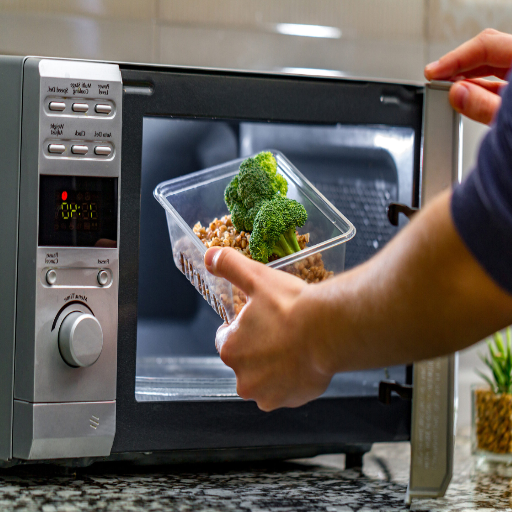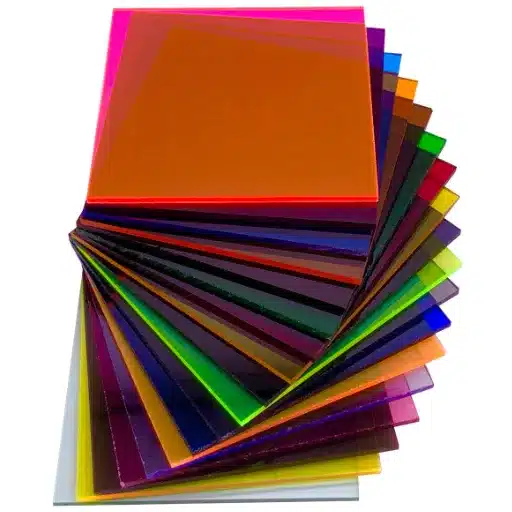Microwaves have been considered an excellent kitchen convenience. Every plastic, however, is not suitable for heat from a microwave. Certain types of plastic can leach harmful chemicals, causing food contamination and health hazards to human beings. This blog tries to bring out all the basic information needed to analyze which plastics can be used safely in the microwave and which cannot, thus giving utmost clarity and guidelines to guarantee your protection and peace of mind. By the time you finish reading this, you will have complete knowledge to identify suitable materials, helping you make wise choices for healthier everyday life practices.
Types of Plastic and Their Microwave Safety
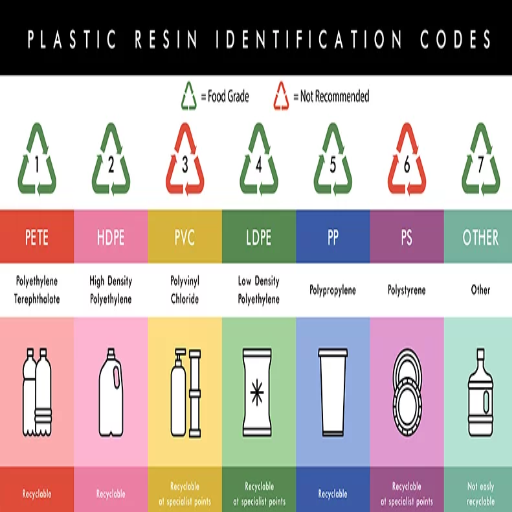
Common Plastic Types Used in Microwaves
Understanding the types of containers and their compatibility with microwaves is very important in ensuring safe food preparation. The following section will be a list of plastics with their microwave safety consideration:
Polypropylene (PP): Polypropylene is a strong plastic generally used for food storage purposes and some microwave-safe dishes. It resists higher heat and is also less likely to leach hazardous chemicals when heated; ensure that containers made of polypropylene have a microwave-safe symbol.
Polyethylene Terephthalate (PET or PETE): Used largely in beverage bottles and some food packaging, PET is not recommended for microwave use. Although it is fairly strong and light in weight, its structure could melt at high temperatures, releasing dangerous substances.
High-Density Polyethylene (HDPE): HDPE is a rigid plastic and is generally used for making containers for milk and similar containers. Though it will withstand moderate heating, it usually never says microwave-safe. Always look for specific labeling.
Low-density polyethylene (LDPE): LDPE is a flexible plastic made for plastic wraps. Though some are heat-resistant, others might release chemicals when microwaved unless marked safe for microwave use. To avoid any contamination, it is best to choose microwave-safe wraps.
Polystyrene (PS): Polystyrene is commonly used in disposable takeout containers, cups, and foam trays and is best avoided in microwaves. When exposed to heat, it tends to melt and give off substances that may be hazardous.
Polycarbonate (PC): In essence, it is just strong and clear and used for reusable dishware; however, many older polycarbonate products were made with BPA, a chemical that can leach into food when heated. The best way to look for the BPA-free label when considering microwave use.
With the awareness of these materials and their properties, one can put safety first and avoid risking chemical leaching. Always look for microwave-safe markings on the product!
Identifying Microwave-Safe Plastics
Not all plastics are created equal, and assessing whether a plastic article is truly microwave safe requires some attention to its composition and labeling. Microwave-safe plastics are designed to tolerate the high heat of a microwave without warping, degrading, or leaching harmful chemicals into food.
Proper labeling is one main factor that identifies microwave-safe plastic products. Containers for microwave use are usually marked with symbols for “microwave safe” or clear directions. Such labeling assures compliance with safety standards set by regulatory bodies. Apart from this, plastics with code #5 (polypropylene) are generally safer to microwave because of their heat resistance and stability at high temperatures.
Use microwave-safe plastic cautiously. Research has established that prolonged heating may still degrade certain plastics while aggravating the situation of leakage. To be safer, keep heat exposure as low as possible, use the microwave at medium power, and avoid putting exceedingly greasy or acid-rich food into the plastic.
This, coupled with an understanding, provides a choice in ceramic or glass containers, which are highly durable and safe for food heating. These materials remove the worry of chemical leaching while being equally effective in microwave use. From these considerations, mindful selection and practices go hand-in-hand to improve food safety and peace of mind when using microwave-safe plastics.
Plastics to Avoid in the Microwave
Understanding which plastics are not to use in the microwave to ensure food safety and avoid any health issues is paramount. Some plastics, especially those not labeled microwave-safe, may release dangerous chemicals when subjected to excessive heat. Plastics such as polycarbonate, usually identified by the recycling code of #7, may carry BPA, a chemical implicated in many health repercussions. Polystyrene (#6), typically found in disposable plates and takeout containers, could break down under heat and release styrene, becoming a concern in human health issues.
Next to be avoided are plastics coded with 3, made from polyvinyl chloride (PVC). PVC plastics may contain phthalates, which could leach into heated food. Moreover, if not labeled microwave-safe, plastic wraps could melt on heating and release some chemicals into the food. These substances have been linked to health issues, and it is believed that even small doses, over time, can have a cumulative effect on the health of an individual. Prioritizing plastics labeled with the codes #1 (PET), #2 (HDPE), #4 (LDPE), or #5 (PP), which are generally considered to be safer microwave options when explicitly labeled microwave-safe, would be a good start toward safer food preparation practices.
Understanding Plastic Labels and Symbols
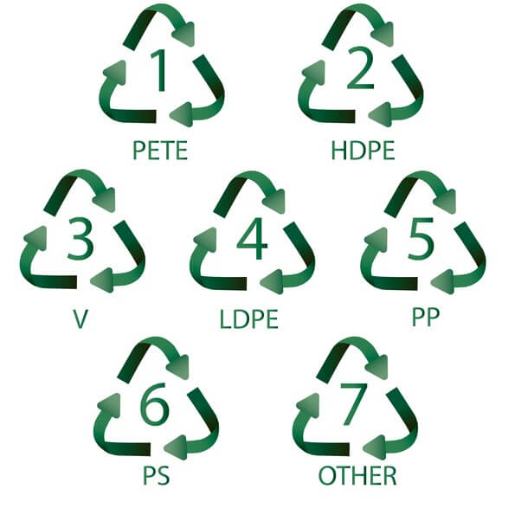
Decoding the Recycling Symbols
These recycling symbols, numbers within the triangular recycling image, indicate what kind of plastic the product is made of and its recyclability. Knowing the symbol can help consumers determine if the article is safe and can be disposed of using environmentally conscious methods. The significant symbols are as follows:
1 (PET or PETE – Polyethylene Terephthalate): These bottles are mostly for water and soft drinks. PET is light and strong and can be recycled almost anywhere. These plastics, however, are meant to be for one-time use, as chemicals may be leached out if used repeatedly over time.
2 (HDPE–High-Density Polyethylene): Found in containers for milk, detergents, and shampoos, HDPE remains sturdy, does not leach chemicals, and is considered one of the safest plastics for food and beverage storage. Most recycling programs accept it.
3 (PVC—Polyvinyl Chloride): PVC is used in pipe manufacture, food wraps, and some bottles, and it is hardly recycled. Its manufacturing and disposal may emit toxic substances; therefore, its use for food and drink should be limited wherever possible.
4 (LDPE – Low-Density Polyethylene): Used extensively for grocery bags, food storage, and flexible films, LDPE plastics are often not accepted by curbside recycling programs but are considered safe for specific applications due to negligible leaching risks.
5 (PP-Polypropylene): Polypropylene is heat-resistant and commonly used to manufacture yogurt containers, straws, and caps. It is safe for reuse and recycling in regions with exceptional facilities.
6 (PS-Polystyrene): The ubiquitous Styrofoam is used for disposable coffee cups and food containers. However, due to its low recycling rate and the possibility that it may leach harmful chemicals upon heating, alternatives are far preferable.
7 (Other-Miscellaneous): This consists of many different plastics, such as polycarbonate, which is supposed to contain BPA. Usually found in reusable water bottles and some food containers, it has sporadic recycling possibilities and should be treated cautiously, mainly when used for food storage.
If consumers were willing to familiarize themselves with these labels and what they stand for, they would always make wise choices and hence play their role in better waste management, ultimately lowering the environmental footprint with health and sustainability.
What “Microwave Safe” Really Means
Suppose a product says that it is microwave safe. In that case, the material has undergone testing to ensure that it will not melt or warp when subjected to the heat of a microwave or that it will not leach harmful chemicals into the food. The manufacturer declares such labels and implies that the product can be reheated or cooked in a microwave oven. However, this does not signify the absolute safety of the materials concerned. Some substances, like certain plastics, might release trace chemicals when heated mildly over time.
Consider this: containers made from polypropylene (PP) are generally considered microwave safe, given the plastic’s high resistance to heat. However, the consumer should account for the “microwave safe” classification and avoid using plasticware if it is damaged or scratched because the wear or scratch may increase chemical leaching potential. Glass and ceramic types of containers are recognized as safer alternatives because these materials are non-porous and do not leach chemicals. Still, they must also be labeled microwave safe to indicate they can withstand thermal stress.
It is also important to check any polystyrene (PS) or PVC plastics you would like to microwave, as these tend to liberate nasty substances when heated. Always look out for that specific symbol or label, be it the microwave logo or explicit text stating “microwave safe.” Responsible usage ensures your health and even the longevity of your kitchenware.
Recognizing BPA and Phthalate Risks
Bisphenol A (BPA) and phthalates have the same suffixes but different chemical compositions and harmful effects. They pose health threats and have long since become a matter of social awareness. BPA can harden plastics in reusable water bottles, containers, and canned food linings. Phthalates make plastic products more flexible when added; these chemicals are found in food packaging, plastic wraps, and even personal care products.
The alleged effects of BPA include endocrine disruption that can interrupt hormone regulation, eventually affecting human reproduction, development, and metabolism. In such cases, phthalates cause respiratory problems, atypical development of children, and hormonal imbalance. BPA and phthalate preventives include checking for the “BPA free” or “phthalate free” label and favoring glass or stainless steel containers to store food and drinks. Less exposure of plastic to high heat conditions, such as microwaving or dishwashing, may diminish the leaching of chemicals from plastic into food or beverages.
Health Concerns Linked to Microwaving Certain Plastics
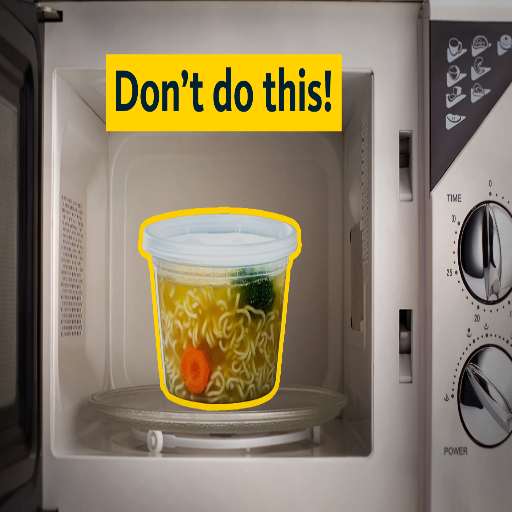
Potential Chemical Leaching
When heated sufficiently in a microwave, certain types of plastics can cause the leaching of hazardous chemicals into food or drinks. It has been found that plastics containing BPA and phthalates, a group of chemicals used commonly to confer durability and flexibility, are very susceptible to leaching. The studies have identified factors contributing to chemical leaching, including more extended periods of exposure to heat, fatty or acidic foods, and abrasion or cracking of the plastic through repeated use.
For instance, BPA exposure potentially poses risks of hormonal disruption and the increased incidence of metabolic disorders, while phthalates may cause reproductive issues and developmental delays. To avoid these risks, experts suggest never heating food inside plastic containers and always using microwave-safe glass or ceramic alternatives. Doing so will lower the risk of unwanted chemical contamination entering your meal.
Impact of Heat on Plastic Materials
When plastic materials—that is, those used for food storage—are heated, chemical changes occur that may have health and environmental consequences. When heated, plastics may release hazardous chemicals, such as bisphenol A (BPA) and phthalates, that will leach into food and drinks, posing a long-term threat to human health. The study of 2023 indicated that repeated use, heating, or microwaving of plastics, mainly low-grade or poorly labeled ones, amplifies this chemical release.
High temperature can serve as another insult by degrading plastics at much faster rates in different environmental matrices, with further aggravation by introducing microplastics into the surrounding environment. Microplastics have been found in freshwater systems, soils, and even human biological samples, indicating the far-reaching effects of improper plastic disposal and use. Selecting heat-stable materials such as stainless steel, borosilicate glass, or ceramics may prevent those risks, protecting one’s health and the environment.
Long-term Effects of Microwaving Unsafe Plastics
From a human health and environmental standpoint, microwaving plastic that is not meant for heat exposure can have grossly far-reaching consequences. Unlike heat-resistant plastics, repeated heating destabilizes these plastics at higher temperatures, releasing toxic chemicals such as bisphenol A (BPA) and phthalates into the air, foods, and beverages. Prolonged exposure has been linked in literature to endocrine disruption, retardation in children, elevation of cardiovascular diseases, and carcinogenicity.
In terms of the environment, the accelerated degradation of microwaved plastic films facilitates the dispersal of microplastics and nanoplastics into ecosystems at an alarming rate. It has been shown that these particles are found in marine wildlife in more than 50 percent of cases, thereby giving rise to risks for biodiversity and entering mankind through seafood consumption. Furthermore, incomplete degradation of plastic compounds leads to the accumulation of persistent organic pollutants (POPs), which are best known for their persistence in chemical stability and their devastating effect on biological organisms.
To reduce such health and eco-risks, safe methods need to be employed, such as using microwave-safe glass or ceramic containers and avoiding single-use plastics themselves. Intensive awareness programs and investment in the innovation of sustainable materials must be undertaken to mitigate the long-term impacts of improper use of plastic materials in high-heat environments.
Best Practices for Using Plastic in the Microwave
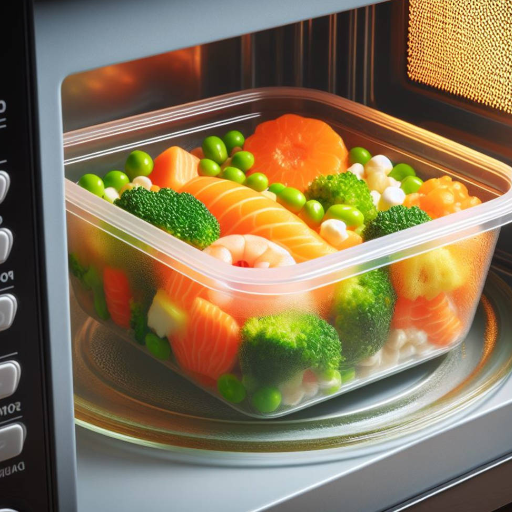
How to Choose the Right Microwave-Safe Container
When choosing the appropriate microwave-safe container, consider health and environmental issues. First, search for containers that have the words “microwave-safe” on their labels or packaging materials. This means that the material has been tested and found to be safe against high temperatures without possible chemical leaching. Glass, ceramic, or Grade-A BPA-free Plastics are commonly accepted as more highly resistant to heat and chemical degradation.
Separately, thickness and durability greatly distinguish containers. Thin or low-grade plastic containers are prone to becoming warped or melted when in contact with heat, which might increase the potential of chemical leaching. Do also check the container for cracks, discoloration, or general wear and tear because these conditions will make it unsafe to be used in the microwave.
During reheating, use lids with vents or leave a small section open so that steam can escape and lessen pressure build-up. Avoid containers not meant for heat exposure, such as yogurt tubs or disposable take-out containers, which tend to contaminate microwaved food with toxins. Lastly, knowing how investing in quality reusable containers benefits you long-term is a first step toward building a sustainable life.
Tips for Safe Microwaving
To maintain safety and convenience, following best practices when working with microwaves and related guidelines given by a reliable source is essential. Always use containers that are microwave safe and are clearly labeled as such by the manufacturer. Containers could be made from glass, ceramic, or plastic and designed for microwave use. They will not give way to heat or leach harmful chemicals. Avoid dishes with any metallic parts or gold or silver designs, as sparks may be generated, or the microwave may suffer damage.
When renewing leftovers, the food should be stirred or rearranged halfway through heating to prevent uneven warming or the presence of cold spots that might allow bacterial growth. Covering with a microwave-safe cover or a damp paper towel reduces mess while waterproofing, which is suitable for food quality. Do not fill the containers to the brim for liquids like soup or tea because they may boil over; hold on to your containers after heating to avoid burns.
Further, many microwaveable foods and frozen meals come with detailed instructions, and following them will ensure safe preparation and the best flavor. Investing in a food thermometer will soon prove to be an extra precaution to ensure that reheated foods reach a temperature of at least 165°F (73.9°C) to destroy viable pathogens. Lastly, regular cleaning will keep the microwave from building up residues that may, over time, hinder food safety and even impact appliance operation.
Alternatives to Plastic Containers
Using alternative types of containers reduces the environmental impacts of plastics and adds to health hazards linked with certain types of plastics. Glass containers offer the best option because of their sturdy nature and non-toxic attributes. They do not stain or absorb odors, and are suitable for hot or cold food. Many are microwave- and dishwasher-safe. Stainless steel storage boxes are another durable and environmentally safe option and are often insulated for thermal purposes to keep food hot or cold for longer. Silicone containers are a very flexible option for the lightweight set: they are reusable and sometimes even collapsible, thereby saving some space.
Other creative solutions include beeswax wraps, which have entered the scene as a sustainable way to cover bowls or wrap food. They are reusable, easy to clean, and biodegradable. Showcasing bamboo and other plant-based materials is becoming increasingly common, with many companies now manufacturing food-safe compostable containers and utensils from these resources. Ceramic containers are another durable and downright gorgeous selection for at-home uses. Lessening the reliance on single-use plastics in favor of these alternatives allows for functional, long-lasting storage solutions.
Conclusion: Making Informed Choices About Microwave Use
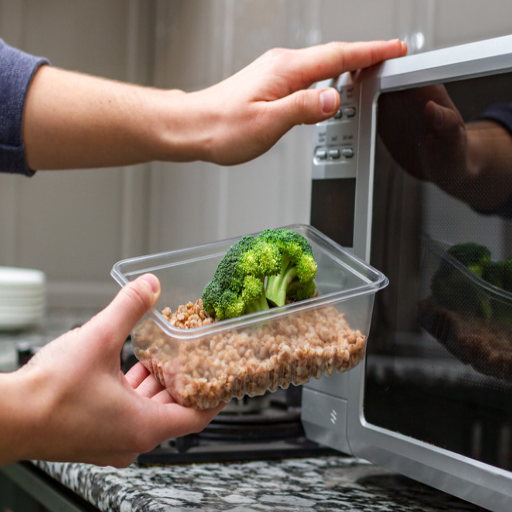
Summarizing Key Points
From my perspective, knowledgeable microwave use choices are based on convenience versus safety and sustainability. When a person has to reheat or, in some cases, cook something, I need to make sure that containers are labeled microwave-safe so that chemicals are not leaching or contaminating the food, and my meals are heated evenly. This means staying clear of single-use plastics, such as taking the glass or ceramic option, or any other material legitimately microwave safe. This way, I protect myself and contribute to sustainability by encouraging fewer disposable products that barely last a couple of uses.
Sustainability is considered as well. When I go for alternatives such as compostable or reusable containers, I do my part to minimize the environmental harm caused by disposable plastic waste. To align with my goal of promoting an environmentally aware lifestyle, investing in excellent containers, be it for food storage or simply heating food, is what I do while still being able to maintain my life. Convenience is a matter, but convenience will be about choices that benefit my health and our planet.
Final Recommendations for Safe Microwaving
To ensure safe microwaving, I carefully select containers labeled as microwave-safe so the harmful chemicals do not leach into my food. Glasses and ceramics are my favorite choices for their heaviness and nontoxic nature when exposed to heat. Going plastic? I always check for the BPA-free label and ensure the microwave use label is also printed on it. Avoiding single-use plastic never hurts one’s health and engenders a greening vibe.
I also keep a microwave-safe lid or cover to limit splattering and retain moisture during heating. The lid is never fully sealed to allow steam to escape and avoid pressure buildup. Another important step I take is stirring food halfway through heating to help distribute heat evenly and avoid hotspots. These requirements on squishing safety with efficiency would go with me every single time I use a microwave.
I am also keen to inspect microwave-safe containers for signs of damage, such as cracks or warping, over their shelf life, which could affect their safety. I always follow the suggested reheating times and lower power for delicate foods so that safety is increased up to the quality of the food. The practice gives me peace of mind while nurturing an eco-friendly diet that drives my long-term goals.
Reference Sources
- Is It Safe to Microwave My Food in Plastic? – Bennett Plastics
- Microwave Safe Plastics Guide – ePackage Supply
- Definitely Do Not Put Plastic in the Microwave – Bon Appétit
- Microwaving Food in Plastic Containers – The American Journal of Medicine
- Plastic in the Microwave: Is There Really Any Danger? – Reddit AskScience
- Top PC Plastic Pellets Suppliers in China
Frequently Asked Questions (FAQs)
1. Why is it unsafe to microwave some plastics?
Certain plastics, when heated, may aerosolize toxic chemicals such as bisphenol A (BPA) and phthalates; these substances can leach into food or liquids and represent a health risk. Further, these substances may warp or melt at high temperatures, contaminating the food.
2. How do I know if a plastic container is microwave safe?
Look for a microwave-safe label or symbol on the bottom of the container. These labels mean that the material has been tested at microwave use and deemed not to release harmful chemicals or degrade in physical strength. If nothing is printed on the container, microwave at your own risk.
3. Are single-use plastics safe for heating?
No, single-use plastics, such as food packaging, takeaway containers, and plastic water bottles, are not designed for heating. These materials may distort, leach harmful chemicals, or ignite during microwaving. Always transfer your food to a microwave-safe dish before heating.
4. Which plastics are safe for microwave use?
Plastics recycled #1 (PETE), #2 (HDPE), and #5 (PP) are generally considered to be better options for microwaving, so long as they are labeled microwave-safe. If in doubt, check the packaging or ask the manufacturer for confirmation.
5. What plastics should never be microwaved?
Do not microwave plastics with recycling codes #3 (PVC), #6 (PS), and #7 (other). Once heated, these materials can release dangerous chemicals such as BPA or carcinogenic compounds. Also, avoid thin plastic wraps and all foam products like Styrofoam containers because they melt or ignite.
6. Can plastic film-wrapped food be microwaved?
Plastic wrap in a microwave oven is not recommended unless the wrap states it is microwave-safe. It should not touch the food, as high heat may encourage melting or chemical leaching. Use a microwave-safe cover or lid instead.
7. Are microwave-safe plastics free of risk?
Although microwave-safe plastics have undergone tests in their intended use, some controversies remain about the long-term health effects of microwave use, especially with frequent exposure and exposure at high temperatures. To minimize potential risk, use alternatives such as glass or ceramic whenever possible.

